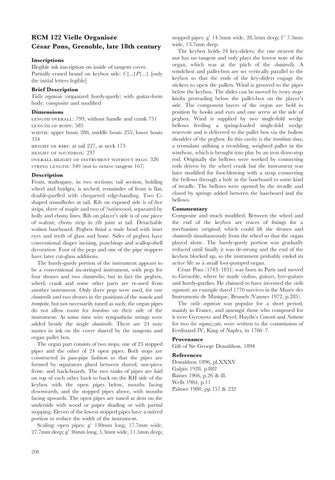50731-199-210
3/4/07
15:00
Page 208
RCM 122 Vielle Organisée César Pons, Grenoble, late 18th century Inscriptions Illegible ink inscription on inside of tangent cover. Partially erased brand on keybox side: C{...}P{...} [only the initial letters legible] Brief Description Vielle organisée (organized hurdy-gurdy) with guitar-form body; composite and modified Dimensions : 799, without handle and crank 751 : 585 : upper bouts 288, middle bouts 255, lower bouts 334 : at tail 227, at neck 173 : 237 : 326 : 340 (nut to octave tangent 167) Description Front, mahogany, in two sections; tail section, holding wheel and bridges, is arched; remainder of front is flat; double-purfled with chequered edge-banding. Two Cshaped soundholes at tail. Rib on exposed side is of five strips, three of maple and two of ?satinwood, separated by holly and ebony lines. Rib on player’s side is of one piece of walnut; ebony strip in rib joint at tail. Detachable walnut baseboard. Pegbox finial a male head with inset eyes and teeth of glass and bone. Sides of pegbox have conventional diaper incising, punchings and scallop-shell decoration. Four of the pegs and one of the pipe stoppers have later cut-glass additions. The hurdy-gurdy portion of the instrument appears to be a conventional six-stringed instrument, with pegs for four drones and two chanterelles, but in fact the pegbox, wheel, crank and some other parts are re-used from another instrument. Only three pegs were used, for one chanterelle and two drones in the positions of the mouche and trompette, but not necessarily tuned as such; the organ pipes do not allow room for bourdons on their side of the instrument. At some time wire sympathetic strings were added beside the single chanterelle. There are 24 note names in ink on the cover shared by the tangents and organ pallet box. The organ part consists of two stops, one of 23 stopped pipes and the other of 24 open pipes. Both stops are constructed in pan-pipe fashion so that the pipes are formed by separators glued between shared, one-piece front- and back-boards. The two ranks of pipes are laid on top of each other back to back on the RH side of the keybox with the open pipes below, mouths facing downwards, and the stopped pipes above, with mouths facing upwards. The open pipes are tuned at slots on the underside with wood or paper shading or with partial stopping. Eleven of the lowest stopped pipes have a mitred portion to reduce the width of the instrument. Scaling: open pipes: g1 130mm long, 17.7mm wide, 27.7mm deep; g3 36mm long, 5.3mm wide, 11.5mm deep;
208
stopped pipes: g1 14.5mm wide, 28.5mm deep; f 3 7.3mm wide, 13.7mm deep. The keybox holds 24 key-sliders; the one nearest the nut has no tangent and only plays the lowest note of the organ, which was at the pitch of the chanterelle. A windchest and pallet-box are set vertically parallel to the keybox so that the ends of the key-sliders engage the stickers to open the pallets. Wind is grooved to the pipes below the keybox. The slides can be moved by ivory stopknobs protruding below the pallet-box on the player’s side. The component layers of the organ are held in position by hooks and eyes and one screw at the side of pegbox. Wind is supplied by two single-fold wedge bellows feeding a spring-loaded single-fold wedge reservoir and is delivered to the pallet box via the hollow shoulder of the pegbox. In this cavity is the tremblant doux, a tremulant utilising a trembling, weighted pallet in the windway, which is brought into play by an iron draw-stop rod. Originally the bellows were worked by connecting rods driven by the wheel crank but the instrument was later modified for foot-blowing with a strap connecting the bellows through a hole in the baseboard to some kind of treadle. The bellows were opened by the treadle and closed by springs added between the baseboard and the bellows. Commentary Composite and much modified. Between the wheel and the end of the keybox are traces of fixings for a mechanism (original) which could lift the drones and chanterelle simultaneously from the wheel so that the organ played alone. The hurdy-gurdy portion was gradually reduced until finally it was de-strung and the end of the keybox blocked up, so the instrument probably ended its active life as a small foot-pumped organ. César Pons (1743–1831) was born in Paris and moved to Grenoble, where he made violins, guitars, lyre-guitars and hurdy-gurdies. He claimed to have invented the vielle organisée; an example dated 1770 survives in the Musée des Instruments de Musique, Brussels (Vannes 1972, p.285). The vielle organisée was popular for a short period, mainly in France, and amongst those who composed for it were Gyrowetz and Pleyel; Haydn’s Concerti and Notturni for two lire organizzate, were written to the commission of Ferdinand IV, King of Naples, in 1786–7. Provenance Gift of Sir George Donaldson, 1894 References Donaldson 1896, pl.XXXV Galpin 1928, p.882 Baines 1966, p.26 & ill. Wells 1984, p.11 Palmer 1980, pp.157 & 232
